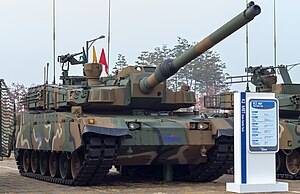K2 Black Panther
| K2 Black Panther | |
|---|---|

The K2 Black Panther on static display
|
|
| Type | Main battle tank |
| Place of origin | South Korea |
| Service history | |
| In service | 2014–present |
| Production history | |
| Designer | Agency for Defense Development |
| Manufacturer | Hyundai Rotem |
| Unit cost |
₩7.8 billion (production batch 1) US$8.5 million (constant 2009 USD) |
| Produced | 2013–present |
| Number built | 100 (200 planned) |
| Specifications | |
| Weight | 55 t (54 long tons; 61 short tons) |
| Length | Overall: 10.8 m (35 ft 5 in) Chassis : 7.5 metres (24 ft 7 in) |
| Width | 3.6 metres (11 ft 10 in) |
| Height | 2.4 metres (7 ft 10 in) |
| Crew | 3 (commander, gunner, driver) |
|
|
|
| Armor | Classified type of composite armour with ERA and NERA modular add-on armour in addition to soft-kill and hard-kill anti-missile defense systems |
|
Main
armament |
120 mm (4.72 in) 55 caliber smoothbore gun (40 rounds) |
|
Secondary
armament |
1× 12.7×99mm (.50 BMG) K6 heavy machine gun (3,200 rounds) 1× 7.62×51mm NATO coaxial machine gun (12,000 rounds) |
| Engine | 4-cycle, 12-cylinder water-cooled diesel 1,500 hp (1,100 kW) |
| Power/weight | 27.2 hp/tonne |
| Suspension | In-arm Suspension Unit |
|
Operational
range |
450 kilometres (280 mi) |
| Speed | Paved road: 70 km/h (43 mph) Cross country: 50 km/h (31 mph) Acceleration from 0–32 km/h (0–20 mph) in 7 seconds |
The K2 Black Panther (Hangul: K2 '흑표'; Hanja: K2 '黒豹') is a South Korean main battle tank that will replace most of the M48 Patton tanks and complement the K1 series of main battle tanks currently fielded by the Republic of Korea. Mass production commenced in 2013 and the first K2s were deployed with the armed forces in June 2014. The K2 costs over US$8.5 million per unit.
In 1995, the South Korean Agency for Defense Development (Hangul: 국방과학연구소) was given the task of developing a modern armored fighting vehicle based upon Korean state-of-the-art domestic technologies. It was intended for this development program to further modernize the Republic of Korea Army, despite the superior capability of existing K1 and K1A1 designs versus existing North Korean tanks, most of which are aging T-55s and Type 59s. Emphasis upon indigenous technologies would also allow the proposed vehicle to enter the export market without licensing difficulties.
Early design variants included a version with an unmanned turret, which was later scrapped in favor of manned turret designs. It was also planned for the vehicle to be equipped with Rheinmetall's experimental 140 mm smoothbore gun, though this had to be abandoned when Rheinmetall ceased development upon the rationale that its current weapon, the 120 mm/L55 would be more than adequate to counter prospective armored threats for the foreseeable future. The K2 was subsequently reconfigured for the 120 mm/L55, though it is capable of mounting the 140 mm gun with minimum modifications should the need arise.
The design became production-ready in 2006, following 11 years in development and a research budget expenditure of approximately US$230 million, and entered the production phase on March 2, 2007 in Changwon, South Korea. It was planned that the K2 would feature a domestically-designed powerpack, based upon the German-designed MTU-890, comprising a Doosan Infracore Corporation 1,500 horsepower (1,100 kW) 12-cylinder diesel engine and a S&T Dynamics transmission. However, this encountered recurrent technical trouble in testing, leading to a delay in operational deployment of the K2 for 2 years.
...
Wikipedia
